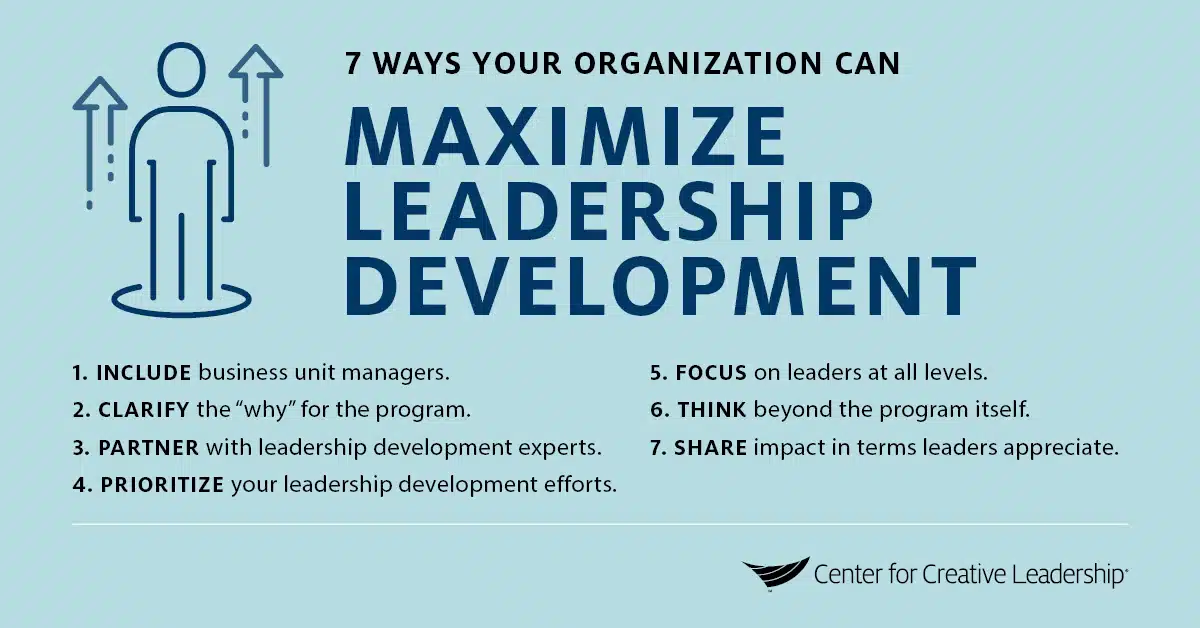Introduction
When we ask clients what kind of return they’re seeking from a leadership development initiative, they usually respond in terms of how the initiative can have a visible, measurable impact on the organization.
If you want maximum impact from your organizational leadership development investment, know that many factors drive ROI. We offer these 7 key recommendations that can help your organization ensure lasting and meaningful success.
How to Maximize the Impact of Organizational Leadership Development
7 Tips for a More Successful Leadership Development Initiative
1. Involve your business unit managers.
It’s all about alignment. As heads of the business units and the direct managers of the program participants, the business unit leaders directly impact the mindset participants will have in the program, as well as the environment they will return to when the program is over. If participants return to their work and hear “I don’t care what they told you in the program, here’s the reality around here,” then little behavior change is likely to happen.
2. Clarify the why for the program.
When we conduct leadership development programs, we often ask participants why they’re there. Sometimes, as many as 1/3 of the class answers with some version of “I was told to be here by HR/the organization.” When a facilitator hears that, they know they have their work cut out for them, because if participants don’t see the purpose in participating, they’ll likely spend those days with their bodies in the program and their minds elsewhere.
We encourage participants to have a conversation with their direct manager prior to participating in our programs to agree on what the participant should focus on during the program, what outcomes the manager expects, and the support the manager will give to the participant following the program. There are key things bosses can do to signal support.
3. Partner with leadership development experts.
As a client, you should have confidence that your leadership development provider has deep expertise in leadership and in your organization. Your provider should take time to understand your current environment, culture, and strategy. And you should treat your provider as a true partner to your organization, keeping your contacts abreast of any important shifts occurring in your business that might be affecting your people. This helps make the learning experience more impactful for the participants.
We once ran a program that received a low end-of-program evaluation score, but afterwards, when we talked with the client, we discovered that a large re-organization had just been announced within the company and everyone was worried about losing their jobs. Had we known of this context, we might’ve been able to help participants work through the change during the workshop.
An effective partnership is one in which your provider is a partner who understands your organization’s unique context and culture, with insights gleaned through a rigorous discovery process, and they’re able to take that information and tailor the program for maximum ROI, according to your needs.
4. Prioritize your leadership development efforts.
There are many reasons an organization invests in leadership development. Some common themes include: equipping new and emerging leaders so they start off on the right foot, preparing high-potential leaders for jobs at the next level, or addressing specific organizational challenges such as rapid expansion or a cultural transition. Resources are often tight, and most leadership development initiatives can’t do everything on their wish list. It’ll be important to partner with business unit leaders to determine what’s most critical and which initiatives they can support.
5. Don’t focus only on senior-level leaders.
While resources may require you to prioritize your plans, that doesn’t mean you can afford to neglect the development needs of leaders at other levels. One of the challenges of leading an internal leadership development function is providing cost-effective development for all leaders. This may take some creativity and innovation on your part.
There are ways to scale and accelerate leadership development across large populations. Consider: Can senior leaders or HR facilitators take on the role of the trainer in programs? Can you use blended or online leadership development tools? Could you license instructional materials and deliver programs with internal trainers? Asking yourself these questions may help you leverage the resources you already have, and you can partner with a trusted provider to support and maximize your internal leadership development initiatives.
6. Think beyond the program itself.
Leadership development initiatives need to go far beyond the short timeframe of the program itself. Initiatives are now often a 6- to 12-month journey, rather than a one-off event. Be sure to plan for all 3 phases — the preparation, engagement, and application stages — to help make learning stick:
- Preparation stage: This involves everything that a participant will go through before the program begins, including pre-reading materials, pre-assessments, and even conversations with managers to determine the area of focus.
- Engagement stage: This includes what happens during the training program itself. How can you create space for the participant to focus on their learning and disengage from their “day job”?
- Application stage: How can you ensure that what’s taught lasts beyond the program? This includes following up with participants’ managers, creating accountability partners, facilitating application activities, and checking in on goals that were set during the program.
Ultimately, the impact of your organizational leadership development initiative should extend and continue long after a program has concluded. Remember that what happens after the program is just as important as what happens during the program.
7. Share the impact of your organizational leadership development initiative in terms your business leaders understand.
At CCL, we often talk about influence using the head, heart, and hands. You need to speak to your stakeholders in terms that are important to them.
- If they speak the language of numbers, be sure to measure the impact of leadership development along the way so you can talk about the ROI of the financial investment and gather and share evaluation data at the end of the program and in the months following it. This will help your stakeholders understand the effectiveness of the program, the learning that occurred, and how the learning was applied back on the job.
- If you have stakeholders who tend to lead more from the heart, be sure to capture real participant success stories. Are they communicating with their peers and employees better? Did a leader who looked like they were “derailing” turn things around? Have employee engagement scores improved? Are retention numbers looking better?
- If your stakeholders enjoy being actively involved in things, how can you get their buy-in and commitment to your initiatives? Can they be the ones to invite people to the program? Will they be on a panel to evaluate action-learning projects? Will they financially sponsor excursions for participants to visit different plants, offices, or facilities? Will they share their own leadership journeys?
In the world of talent management and development, if you can demonstrate significant impact from organizational leadership development investments, you gain visibility and influence. So begin with the end in mind, and be clear about what it is that you’re trying to accomplish with your leadership development efforts. And focus particularly on these 7 factors, which increase the odds of a high ROI and lasting impact from your organization’s leadership development initiatives.
Ready to Take the Next Step?
We can help you create and measure the impact of organizational leadership development.
Make development more accessible with CCL Passport™, our integrated licensing solution that gives you unlimited access to our world-renowned content and solutions so you can scale training across large populations of leaders.
Or, partner with us for highly personalized, targeted, and transformative customized leadership development that’s tailored to your organization’s unique context and challenges.









